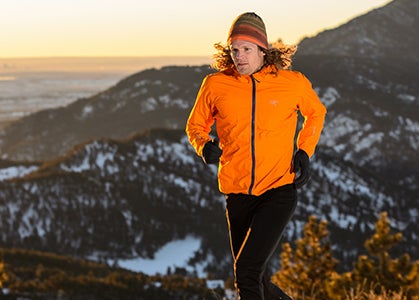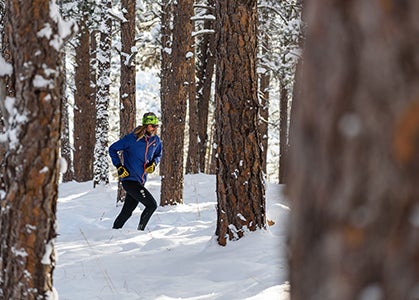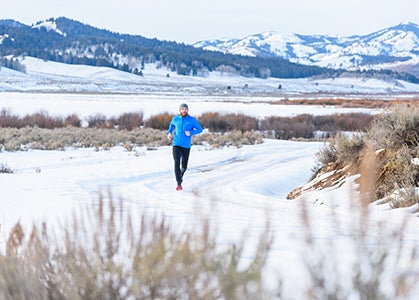New perk! Get after it with local recommendations just for you. Discover nearby events, routes out your door, and hidden gems when you sign up for the Local Running Drop.
I grew up in the Twin Cities—and went to college in central Minnesota—where November through March (or April, if we’re unlucky) can be positively tundra-like. See how many times you can hear the phrase, “It’s not the cold, it’s the wind chill!” before you snap.
I also ran year-round in high school and college; post-collegiately, I had a knack for finding goal races in April. The point is, I’ve been running in the worst imaginable winter conditions since 2005—and I’m still figuring out how to do it best.
Luckily, my home state—and the region beyond—is replete with wiser runners than I. In the pages that follow, you’ll find expert wisdom on gear essentials, how snowbound running affects your training, cross-training alternatives, safety tips and more. So batten down the hatches and get ready for winter’s wild ride.
THE GEAR
I worked in a running store for nearly two years, and approximately every other customer who walked through the doors from November through March had the same question: “So how do I dress to run outside right now?”
Dress Up
Base Layers / These moisture-wicking shirts can be either short sleeve or long sleeve, and are worn next-to-skin.
Mid-Layers / Offering slightly heavier insulation and a looser fit, these long-sleeved shirts can be worn alone or on top of the base layer; quarter-zip tops are favorites, as the zipper allows for venting or warmth.
Pants / Some prefer looser-fitting running pants, which can accommodate a base layer for extra-cold days. Tights are also common, and some come with windproof material in the front.
Shells / An outer layer that can resist wind and/or moisture. These tops and bottoms run the gamut from wispy four-ounce wind shells to multi-layer Gore-Tex armor.
Wick Moisture
Synthetics / These include polyester and its lab-born cousins. Some companies have tried to address the stink factor often associated with such fabrics through antimicrobial treatments.
Wool / Merino wool is climate-adjusting and can help keep your temperature regulated year-round, giving these layers more versatility. It stays relatively stink-free. On the downside, wool can itch when next to skin, and retains more sweat.
Cotton / That old long-sleeved race T-shirt won’t wick a drop of sweat and can get heavy, but you’ll instantly look the part of the grizzled old vet. Obviously, not recommended for winter running.

Get Traction
Many trail shoes offer good traction on loose or packed snow, but hard snow and ice call for additional help.
Springs / Yaktrax Pro ($30) pull-on devices provide a matrix of metal spirals underfoot that provide extra traction in snow, but are little help on ice.
Pins / The Yaktrax Run ($40) and Kahtoola Nanospikes ($50), among others, are pull-on devices sporting metal pins, specifically designed for ice; they also won’t get in your way too badly if you hit a dry section of dirt or pavement.
Microspikes / These are essentially crampons that let you bomb down icy singletrack feeling invincible. They’re overkill for anything less than glare ice, though I have worn them on mostly snowy routes knowing there are a few slick patches ahead. Kahtoola makes the signature Microspikes ($70), though the Yaktrax XTR ($50) is comparable.
Built-in / A few shoes offer extra traction as a permanent part of the shoe (Salomon Spikecross, Icebug BUGrip line), featuring metal pins or hooks atop already aggressive rubber traction on the outsole.
Screws / This option is old school but economical and works well. “Several years ago, runners in our area started installing sheet-metal screws into the soles of old trail shoes,” says Kirby Juntila, 60, of Marquette, Michigan. “They proved to be the most effective traction device to date.” A few companies sell screw kits, e.g. the La Sportiva A.T. Hobnails and Tool ($54) and the ICESPIKE Deluxe Package ($32).
You will want to find a spot on the shoe that both provides traction and avoids poking or putting pressure on your foot from the bottom; this will depend heavily on the model of shoe you use.
Care for your feet
Shoes / Trail shoes’ inherent traction for dirt and mud carries the bonus of giving you grip in the snow. Many stores actually sell trail shoes to road runners during the winter.
To Waterproof or Not To Waterproof?
Many trail shoes are offered with Gore-Tex or eVent booties. While waterproof materials can help keep snow out, they can also keep it in, if it finds its way over the cuff of the shoe. They can also get really warm (though the breathability of waterproof technology has improved in recent years), if your feet chill easily.
Socks / These will likely make a bigger difference than waterproof shoes in keeping your feet dry and therefore warm. Synthetics, wool or wool blends are the ticket due to their wicking properties.
Accessorize
Hats/headbands / They can come light and basic, or heavy, insulated and windproofed; even a light hat will help retain a lot of heat on a cold day.
Gloves / Your hands can be the first things to get cold. It’s not unusual to see collegiate cross-country runners, racing in the late fall, wearing five-dollar, oversized knit gloves alongside their barely-there singlets and split shorts.
Mittens / When the temps sink below freezing, mittens are the bomb for keeping the numbness at bay. Mittens with wind-resistant shells can fit over gloves and provide a second layer; many brands offer a hybrid glove with an attached mitten overlap.
Mask/Neck Gaiter / A simple Buff-style wrap, or a more carefully engineered facemask with nose holes and Velcro in the back is a must-have when the wind picks up.
Wind BriefS / For the fellas, on windy days.
Headlamp / Daylight is scarcer in the winter, and you’ll regularly find yourself at the trailhead before sunrise or after sundown. Headlamps run the gamut in terms of power, price and extra features—I’ve spotted headlamps of questionable quality at Wal-Mart for $10, and have sold plenty of the 575-lumen, reactive-lighting Petzl Nao for $185. There are many solid options for less than $100.
Remember that cold weather can drain your headlamp’s power quickly, so make sure it’s charged up or has fresh batteries; if you’ll be out for an extended time in the dark, consider carrying a spare light or set of batteries.

TACTICS AND SAFETY
How you approach winter running is key to not only your enjoyment, but also to your safety.
Layer Up
Perhaps the most basic rule of winter running is that you should be cold starting out. Your body will warm up significantly within the first mile; if you are comfortable starting out, you will soon find yourself overheating, and dropping a layer, only to doubly freeze in the sweat you’ve accrued.
“For a couple-hour run in the winter, I don’t mind getting a bit sweaty,” says John Storkamp, 37, of Hastings, Minnesota, who has finished the 135-mile Arrowhead winter ultra seven times and once completed the 350-mile Iditarod Trail Invitational in Alaska. But Storkamp notes that avoiding overheating—and the subsequent sweating and cooling off—is crucial on long runs and in winter ultras.
If you’re new to winter running, experiment on short runs to find which layers you need at which temperatures to feel comfortable—though when in doubt, err on dressing on the warm side as you can always drop layers.
Respect the Season
If you’re running in a remote place, and conditions are poor, plan for the unexpected.
“If I am training really long in a remote area, I always have a puff jacket, headlamp, compass, small knife and lighter,” says Storkamp. “If [it’s] really remote, and an area I am not as familiar with, or an area [where it’s] easy to get turned around, I run a GPS, dropping a waypoint at my start area, or, at a minimum, bring a map. I also make sure my wife or someone knows where I am, and when I plan to be back.”
That might be extreme for most of us, but whenever you set out, consider what you would do if you step through thin ice or take a wrong turn, far away from the trailhead, and plan ahead.
Know the Risks
Even with the right gear and planning, runners face inherent risks related to the cold.
Frostbite / When your extremities or skin are exposed to the cold for too long, they can freeze, plain and simple.
“[The affected area] turns red first, then it turns white, then it turns numb,” says Chip Kurt, 59, of Eagan, Minnesota. Chip is my dad, and, though he has never once run outside during the winter, he gained plenty of experience with cold-related maladies as the director of the ski patrol at Welch Village ski area.
“Everyone thinks [frostbite] hurts at first, but you can’t feel it,” says Chip, adding that you need to get inside as quickly as possible to prevent further damage. “Wrap it, blow dry it, do anything you can to warm it up.” But be careful and do so gradually. “Don’t soak it in hot water. Start with tepid water, even cool, then eventually move to warmer water.”
Hypothermia / This is where your body temperature—typically 98.6 degrees—dips below 95, due to improper clothing, getting wet or myriad other reasons.
“The main symptom is that you start shivering uncontrollably,” says Chip. “That can progress to slurred speech and decreased responsiveness.”
The best solution is to get inside, stat. If you can’t, bundle up in as many layers as possible and get off the ground if you can, then do anything to generate body heat, including crunches or squats.
Concussion / If you slip on the ice and bang your head, be on the lookout for headache, delirium, disorientation and slurred speech. If you are with someone who falls, says Chip, ask them basic questions like their name or the day of the week—if they have trouble answering, they likely have a concussion.
Then, get checked out by a doctor as soon as possible, since there may be other complications.

HOW TO RUN IN THE COLD
“What is this white stuff, and how do I run in it?”
I think my friend—visiting Minnesota from Texas for the first time—was being facetious. But watching him stumble around on snow-covered singletrack and wipe out completely on a couple hidden patches of glare ice, I could see that he was legitimately out of his element. Even as a seasoned winter runner, each time the first snow hits, I find myself re-learning, slightly, how to run.
Embrace the Slog
“Snow running is certainly tougher than running on a hard surface at a given pace,” says Ian Sharman, 36, who lives and trains in four-season Bend, Oregon, and runs a coaching service. “It varies depending on the depth and softness of the snow. Plus, icier conditions engage more stabilization muscles and require more focus to avoid slipping, all burning more calories.”
In other words, a five-mile winter run might wind up being the equivalent of a 10-mile summer effort, so it’s important not to get hung up on mileage goals during the winter.
If you are following the well-laid tracks of fat-tire bikes or previous foot traffic, you might be able to nearly match your dry-surface pace and effort on the well-packed snow, and can set your goals accordingly. But if you are postholing or making first tracks after a storm, embrace the fact that you’ll go slower, run shorter and quite possibly work harder anyway.
Hydrate Right
One January, I was training for an April 50K, and headed out on my first three-hour run of the winter carrying the usual handful of gels and water bottle. What I failed to account for was that that water bottle would soon turn into a solid block of ice
“You should have put booze in it,” remarked one friend. But if you’re looking for a serious way to carry water with you through the winter, Storkamp says the investment in an insulated or vacuum bottle (e.g. Nathan Fire & Ice, Camelbak Podium Chill) can keep your water unfrozen for longer. “For [longer] training and racing, a hydration pack underneath an oversized shell jacket will keep it liquid,” he says.
One other trick—heat up your water, even to boiling, in the microwave before putting it in your bottle.
Master the Ice
Running on snow can be fun, if laborious. But ice can be dangerous. A shorter, more cautious stride may allow you to catch yourself when you inevitably slip.
“The main adjustment in snow or ice is to land with a flatter footfall so that there’s a larger surface area to grip the snow or ice,” says Sharman.
But it’s not all doom and gloom.
“There are big benefits to the lack of stability snow and ice running causes,” he says. “It’s a great workout for the core and stability muscles throughout the entire body, which reduces the chance of injury and improves the ability to hold good form late in a race.”
Avoid Nutrition Pitfalls
Being exposed to cold temperatures and limited sunshine can leave you low on a few key nutrients.
Water / Oops. It’s harder to remember to hydrate when you aren’t warm, plus the added effort of running in snow and the extra layers can dehydrate you quickly. “Remember to drink before and after running, even if you aren’t thirsty,” says Lindsey Tucker, a registered dietitian in Minneapolis. She recommends hot black or green tea, or even hot chocolate, as a more seasonal alternative.
Vitamin D / While sunshine exposure dwindles in winter, vitamin D-rich foods are readily available—think salmon, eggs, cod-liver oil or even fortified cereal or juices.
“[Vitamin D deficiency can cause] fatigue and exhaustion despite adequate sleep, decreased training stamina, low mood or depression [and] uncharacteristic body aches and pains,” says Tucker.
A supplement can be used if you are unable to consume sufficient Vitamin D, but see a physician first.
Antioxidants / These illness-fighting substances are crucial in the winter, when we are more prone to the flu or common cold. “Thanks to modern-day farming and transportation, traditionally seasonal fruits and vegetables are available year-round,” Tucker says. “However, out-of-season fruits often provide decreased levels of antioxidants, vitamins or minerals.”
To maximize your antioxidant intake, swap out some summer seasonal produce, such as berries, melon, zucchini, tomatoes and bell peppers, with winter seasonals, like pomegranates, oranges, kiwis, red grapes, kale, collared greens, squash, carrots and yams.
ALEX KURT taught himself to skate ski last year, to the delight of spectators with video-capable phones. He lives in Minneapolis.
This article originally appeared in print in December 2016.